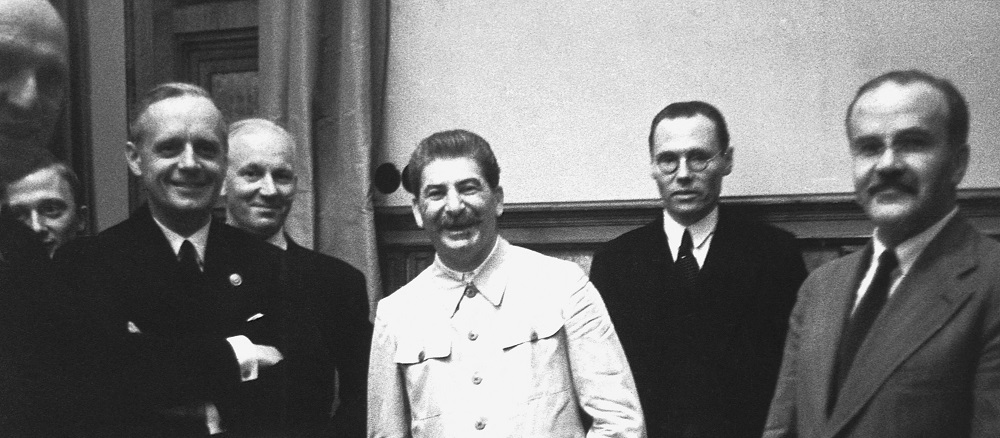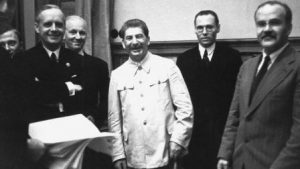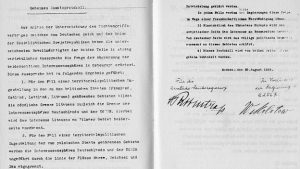El 23 de agosto de 1939 quedará marcado para el resto de la historia por el pacto “Stalin-Hitler”. A nueve días del inicio de la segunda Guerra Mundial, el jefe de la contrarrevolución en la URRS, para resguardar a la oligarquía contrarrevolucionaria, pactaba con el imperialismo de la Alemania Nazi un acuerdo de “paz y ayuda mutua”.
Por Nicolás Zuttión
Este hito fue una de las evidencias empíricas más importantes que demostró el carácter contrarrevolucionario del gobierno de Stalin. La primera consecuencia de la firma del acuerdo es un cambio en la política de la Internacional Comunista, se produce un viraje en la formulación de la propaganda antifascista, “los periódicos “emigrados” alemanes y las novelas de los antifascistas desaparecen como por ensalmo de la biblioteca de literatura extranjera. A partir del 23 de agosto por la tarde, se retiran de todos los cines y teatros las películas u obras antifascistas. La propia palabra “fascistas” desaparece por completo de las columnas de la prensa…”[i].
Camino hacia el pacto
La derrota de la revolución europea que imposibilita la extensión de la revolución a las afueras de la URSS, el agotamiento por la guerra civil y los enfrentamientos defensivos contra más de 15 ejércitos imperialistas, fueron los motivos que provocaron el inicio de un proceso de burocratización de la primera revolución obrera. De esa manera nace y se apodera del poder una casta burocrática que, a la estrategia de la revolución internacional impulsada por la Internacional Comunista, contrapone la teoría del “Socialismo en un solo país”. Exilios obligados y posterior asesinato como el de Trotsky, y purgas a opositores fueron los métodos para blindar una estrategia política conservadora con consecuencias mundiales.
Derrotado en la primer Guerra Mundial y ahorcado por el Tratado de Versalles, el capitalismo alemán se encontraba en una situación crítica que se reflejaba al interior de su entramado social. El empobrecimiento de la pequeñoburguesía y el desempleo creciente en la clase trabajadora eran el panorama perfecto para el crecimiento del partido de Hitler, el nacionalsocialismo.
Trotsky, ante este horizonte, para contrarrestar el ascenso del fascismo en Alemania instaba al “Frente Único Obrero” con el partido socialdemócrata. Concebía en esta táctica defensiva la posibilidad de detener a Hitler, agrupando a los trabajadores alemanes en defensa de sus propias organizaciones y al mismo tiempo ganar a la base socialdemócrata desnudando las inconsecuencias de su dirección. Sintetizando y considerando las diferencias programáticas entre los diferentes partidos, el dirigente del ejército rojo decía que “Las políticas de nuestros partidos se oponen irreconciliablemente; pero si los fascistas vienen esta noche a destrozar el local de vuestra organización, vendremos corriendo, arma en mano, para ayudaros. ¿Nos prometéis que si nuestra organización es amenazada correréis en nuestra ayuda?” Esta es la quintaesencia de nuestra política en el período actual”[ii].
Sin embargo, la política implementada por la III Internacional en manos de Stalin es totalmente opuesta, marcada por el ultraizquierdismo del “Tercer Período” que definía al reformismo como social fascismo, igualando a la socialdemocracia con el nazismo, negándose a la unidad para enfrentarlo y facilitando de esa manera la llegada de Hitler al poder sin oponer resistencia.
Un aviso de Trotsky
Desde inicios de la década del ’30, propio del agudo criterio político que lo caracterizaba, Trotsky pensaba en la posibilidad de una nueva guerra mundial producto de las contradicciones irreconciliables del imperialismo mundial. En ese marco, sospechaba un acuerdo entre Stalin y Hitler. El resguardo del “Socialismo en un solo país” hacía a Stalin capaz de todo. Con el temor de la posibilidad de ser invadido luego de haber purgado la dirección del Ejército Rojo, Stalin, para preservar su status quo, cumplió con el pronóstico y realizó un pacto con el dictador alemán.
En 1939 Moscú presenció el encuentro entre Joachim von Ribbentrop, ministro de Relaciones Exteriores de Hitler, y Viacheslav Molotov, su par del Estado obrero burocratizado, para la firma de un “”tratado de no agresión”. Esta alianza mostró que “…lo que determina la política interna del Kremlin es el interés de la nueva aristocracia en mantenerse, su odio al pueblo, su incapacidad de conducir una guerra. Cualquier combinación internacional reviste algún valor para la burocracia soviética en tanto la libera de la necesidad de recurrir a la fuerza de los campesinos y los obreros armados. Y sin embargo, el pacto germano-soviético es una alianza militar en todo el sentido de la palabra, pues sirve a los objetivos de la guerra agresora imperialista”[iii].
El stalinismo mantuvo oculto una parte del acuerdo, que mostró lo criminal de lo firmado cuando vio la luz. Stalin no sólo no combatió la agresión fascista de Hitler, sino que, como indica Trotsky, coronó el acuerdo con concesiones económicas. De esta forma la burocracia enquistada en la URSS “garantiza a Hitler la posibilidad de utilizar las materias primas soviéticas del mismo modo en que Italia, en su ataque a Etiopía, utilizó el petróleo ruso. Mientras los expertos militares que Inglaterra y Francia tienen en Moscú estudiaban el mapa báltico desde la perspectiva de las operaciones militares entre la URSS y Alemania, los expertos alemanes y soviéticos consideraban las medidas a tomar para salvaguardar las rutas del Mar Báltico en función de mantener las relaciones comerciales de manera continua durante la guerra”[iv].
De todas maneras, el sumun del pacto fue la repartición entre Hitler y su comisario Stalin de Europa Occidental. Polonia funcionó como teatro de operaciones de este acuerdo, siendo invadida en primer lugar por la Alemania nazi a la semana de la firma del pacto. Posteriormente, el 17 de septiembre, son las tropas stalinistas las que toman el control de la otra parte del territorio polaco devastando lo poco que quedaba y asesinando a su pueblo.
Stalin ¿héroe de guerra?
Pensando sólo en resguardar el poder de la casta burocrática que había traicionado la revolución del ’17, Stalin olvidaba que la estrategia final de Hitler era poder despedazar a la URSS. Trotsky, haciendo referencia a estos planes sentenciaba que “Si Alemania consigue emerger triunfante de la guerra con la ayuda del Kremlin, el peligro que correrá la Unión Soviética será mortal. Recordemos que inmediatamente después del acuerdo de Munich Dimitrov, secretario de la Comintern, hizo público -indudablemente por orden de Stalin- un calendario muy explícito de las conquistas futuras de Hitler. La ocupación de Polonia estaba señalada para el otoño de 1939. Luego seguían, por orden, Yugoslavia, Rumania, Bulgaria, Francia, Bélgica… Y luego, al final, en el otoño de 1941, comenzaría la ofensiva contra la Unión Soviética”[v].
La larga noche que atravesó el movimiento de masas a nivel mundial durante la década del ’30 y parte de la del ’40 del siglo pasado, tiene como uno de sus máximos responsables a Stalin. Con total exactitud, lo denunciado por el fundador de la IV Internacional se concretó. Es en 1941 cuando Hitler decide emprender la operación “Barbarroja” para invadir a la URRS. La derrota de la misión del ejército nazi en territorio soviético y la posterior victoria en Berlín, entonces, no son producto de un genio estratega como se supo vender la imagen de Stalin. Con el ejército rojo descabezado durante los “Juicios de Moscú”[vi], el logro mencionado sólo se entiende como resultado del enorme valor del pueblo trabajador ruso.
Tanto las mentiras que postularon a Stalin como el héroe de guerra que venció al fascismo, como el ocultamiento del pacto Molotov-Ribbentrop, sólo se puede entender a partir del funcionamiento del aparato contrarrevolucionario más grande que existió. Una anécdota de Nahuel Moreno, que figura en su libro Conversaciones, ilustra de cuerpo entero lo comentado.
En nuestro país, en el Teatro del Pueblo se solía reunir la vanguardia de izquierda, cuyo principal tema de discusión en ese entonces era la lucha contra el ascenso del nazismo. Moreno y otros compañeros trotskistas asistían a las funciones que luego culminaban con grandes debates y polémicas. En ese marco relató:
“Una noche, siendo las ocho o nueve, nos llegó la noticia, traída por nuestros amigos del diario El Mundo, de que se acababa de firmar el pacto Hitler-Stalin. Yo tomé la palabra inmediatamente para denunciar el hecho y Sergio Satanovsky [su amigo, muy ligado al PC], que estaba en un palco a la derecha del escenario, se retiró. El resto de los estalinistas se quedaron, escuchándome en silencio. Eran la mitad de la concurrencia, y a su vez eran casi en su mayoría judíos.
Alrededor de las doce de la noche volvió Satanovsky, que evidentemente había ido a consultar con el Comité Central del partido si la noticia era cierta. Y entonces sucedió algo que me provocó un impacto tremendo, hasta el día de hoy no lo he podido olvidar. Tomó la palabra y dijo más o menos lo siguiente:
¡Repudiemos a la canalla imperialista que se disfraza de democrática para atacar al pueblo alemán y a su gran gobierno! ¡Es mentira que Hitler persigue a los judíos, es mentira que persigue al PC, no hay campos de concentración en Alemania! Son todas mentiras del imperialismo.
Y a continuación… ¡lo aplaudieron todos los estalinistas! ¡No pudimos ganar a un solo judío del PC para nuestras posiciones! ¡Ni uno! Todos lo aplaudieron”.
Bueno, me quedé anonadado […]. Ahí quedé convencido de que el estalinismo es como una iglesia medieval, nadie duda de nada, todos aceptan lo que dice la dirección. Yo no podía creer lo que veía, aunque los compañeros anarquistas ya me habían prevenido. […] La gran preocupación del PC no son los intereses del movimiento obrero y la manera de movilizarlo, sino los intereses de la burocracia del Kremlin”[vii].
Años más tarde de este pacto, en la misma línea, Stalin acuerda la división del mundo con el imperialismo estadounidense post segunda guerra mundial. De ese acuerdo, que establece la “coexistencia pacífica” para resguardar los intereses de la burocracia estalinista, surge la construcción del Muro de Berlín. Ese símbolo de concreto, producto de las contradicciones acumuladas de una dirigencia que atacó incansablemente los derechos democráticos y económicos de los trabajadores, fue destruido por una revolución que también hizo volar por los aires el aparato contrarrevolucionario mundial más grande que los trabajadores tuvieron que soportar. El resultado de este episodio fue muy contradictorio al perderse las conquistas logradas que aún perduraban en los Estados Obreros burocratizados. Por otro lado, despojó a la clase trabajadora de una loza burocrática que hoy, ante las grandes oportunidades que se presentan, sólo funcionaría como corsé de las rebeliones y revoluciones en curso.
[i] El Partido Bolchevique. Pierre Broué.
[ii] El frente único defensivo. Carta a un obrero socialdemócrata. León Trotsky.
[iii] Stalin, el comisario de Hitler. León Trotsky.
[iv] Ídem.
[v] Ídem.
[vi] Los procesos de Moscú: la consolidación de la contrarrevolución stalinista
[vii] Conversaciones con Nahuel Moreno.






